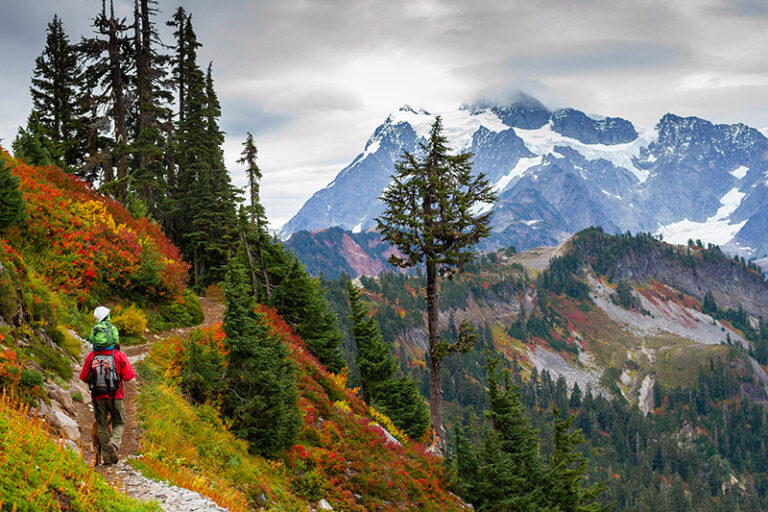John Roskelley Reports Back From Guari Shankar And Talks About Global Warming And The Impact On Mountaineering
As if glaciers, avalanches, and ice fields weren’t enough, mountaineers have a new threat to worry about as they climb the world’s most technical and treacherous peaksglobal warming.
It doesn’t take a glaciologist to figure out that the planet’s glaciers are vanishing into thin air, from the flanks of Everest to Glacier National Park (where scientists predict the park could be glacier free by 2030). And it doesn’t take overwhelming scientific evidence (even though it’s out there) to convince most mountaineers that global warming is a human-aggravated problem that’s posing a real threat to their sport. On many of the world’s summits, no ice may mean no climbing, which is exactly what happened to local climbing legend John Roskelley and his son Jess this fall in their attempt at the unclimbed northeast face of Nepal’s 23,405 Gauri Shankar.
The ambitious climb would have made an impressive encore to their successful 2003 summit of Everest if they hadn’t been turned back by unruly and outright life threatening ice-free conditions. “I was surprised when I got over there how bare the face looked. How melting was taking place at 22,000 feet, because normally that doesn’t happen,” Roskelley explains.
Roskelley had scoped out the route fifteen years earlier on a successful summit of neighboring 23,559 foot Menlungtse. “It looked like this real reasonable route up this rib in the center,” Roskelley recalls. But the face bared little resemblance to the photo he took back in 1990. “I was surprised to look up at this face at 22,000 feet and see these huge icicles. And that meant to me that there was indeed quite a bit of melting going on up high.”
The unsettling conditions weren’t just an inconvenience for the climbers; the shortage of ice had unleashed an unexpected set of treacherous side effects that make crossing a crevasse sound like a game of hopscotch. “When I got up there,” Roskelley remembers, “the risk was exaggerated because of the amount of rockfall, little avalanches coming down, things like that, but mostly it was because of the change in conditions from my photo from 1990 of what the face looked like. It was just a tremendous difference in the amount of rock and snow that was exposed.”
As the upper ice and snow continues to melt, Roskelley explains, more and more rocks continue to be set free to rocket downhill at the heads and limbs of unsuspecting climbers. “The glacier below Gauri Shankar’s face is one big brown mess of rockfall. You can’t even see snow or ice on it. It’s obviously been melting back for years.”
Not ones to be turned back by mere flying boulders and the forces of global warming, the Roskelleys put in their time on the mountain, searching hard for a semi-sane way to the summit. “We were there for two weeks in base camp. We went up one ridge, went up another. We reconnoitered up to the base of the face. We watched it, looked at it, listened to it.” Grudgingly, they finally decided that the intended route was just too dangerous to justify.
“Then we tried a different route, and that just turned out to be a mess,” Roskelley recalls. “Up to the first two thousand feet, up to where our first camp was there was no water, no snow. So we ended up having to carry a five-gallon jug up there for water. That’s how bad it was, there just wasn’t any snow or ice.”
On their improvised ridge route attempt, melting ice and snow had left behind another set of extremely dangerous climbing conditions. “On the ridge it was the same deal. It wasn’t that the rocks were falling on you. The moment you touched something, something else would move and they were big things. They weren’t these little boulders that you could just kick over. These things were massivethey were car sized, and they were sitting on top of this ridge. I’m not kidding,” Roskelley exclaims, “it felt like these things were going to topple on you at any time.”
So what’s behind such dramatic changes? The invisible hand of global warming and the freeze and thaw magic of melting snow and ice are likely culprits according to Roskelley and a growing number of climbers world-wide. “I just feel that it has a great deal to do with the warming of the temperatures in the Himalayas,” explains Roskelley. “And I think the Sherpas have had that same feeling, but they didn’t know what it was.”
Despite the disappointment of having to abandon the summit attempt, Roskelley believes the northeast face could still be done in the winter or early spring. “You’ll have to change the routes you’re going to be doing, and then climb later in the fall or earlier in the spring. But rockfall is a major problem on any steep face, and you’re not going to avoid it.”
All of this may mean major changes for the future of mountaineering. “They’re going to have to revise all of the guidebooks,” Roskelley says, only half-joking. “This is a whole new deal for people like writers. I mean they can just make a mint going up to look at all these climbs up in the Canadian Rockies and saying hey, this is no longer an ice route.”
On the expedition’s web site, Roskelley ribs readers that “One would have to wear a flak jacket and a H3 Hummer for a helmet,” referring to climbing the northeast face, “but it can be done.” Seriously though, as the planet continues to warm, and the world’s highest peaks change forever, it might not be long before innovative climbers respond with new tools, gear, and techniques (like titanium climbing armor or rock loosening percussion grenades maybe?) that will become the next generation’s post-glacier mountaineering standards.
Over the next 100 years, as the Earth warms between 2 and 5 degrees as many scientists predict, the real tragedy is that whatever havoc global warming visits on the climbing world will pale in comparison to the potential impact on coastal communities, agricultural production, and entire native ecosystems. But despite such grave possibilities, and no matter how warm it gets, mountaineering will surely survive as long as there are mountains left to climb.













